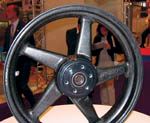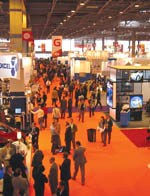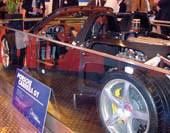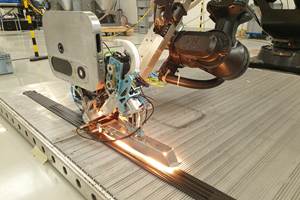SAMPE Europe/JEC Composites 2005
Advanced materials reap rewards, enter new arenas of application in annual Parisian showcase.
|
The 26th SAMPE Europe Conference, held in conjunction with the JEC Composites Show (April 5-7, 2005) in Paris, France, celebrated much that was new this year, emphasizing the rapid growth of nanotechnology and its impact on M&P professionals in the event's theme, "Nanotechnology Assists Leadership & Success of the Composites Technology." Keynoter Tia Benson Tolle, chief of the U.S. Air Force Research Laboratory's (AFRL) Structural Materials Branch (Dayton, Ohio), set the stage with "From Composites to Nanocom-posites: Multifunctional Performance for Aerospace Applications." Her presentation outlined the unique processing challenges and the huge advantages inherent in the use of nanomaterials, particularly in the areas of thermal performance and electrical conductivity. |
|
SAMPE Europe president Klaus Dreschler, in the Conference's opening session, stated that the organization's membership (~900) was approaching its previous highest level and challenged the group to reach a new goal of 1,000 members. In addition, Dreschler called on SAMPE to increase its activities globally, noting that U.S., European and Japanese chapters were working more closely together. He announced the formation of a fledgling SAMPE Europe chapter in the Czech Republic. This year's conference attracted 93 papers, offered in 21 sessions, with three sessions devoted entirely to nanotechnologies. SAMPE Europe also organized and co-sponsored the JEC's Aerospace Forum chaired by Drechsler. Among the most notable presenters was Stephen Tsai, professor emeritus of the Aeronautics and Astronautics Dept. at Stanford University (Stanford, Calif.), who in his presentation "Thin Ply Technology: A New Opportunity For Composites," discussed a new laminate technology considered to be a significant new way to optimize composite structures. Tsai pointed out that research into composite constructions that use "spread" tows, that is, tow fibers arranged in thin, flat unidirectional orientations, such as tapes, can be woven and incorporated into laminates that are thinner than those possible with woven tow, yet exhibit the same strength as the tow before it is spread. The resulting laminate exhibits greater durability (e.g., in tension fatigue). The method therefore provides composites fabricators the opportunity to make parts using less material at reduced cost. (See also "Market Trends," in this issue, for Henrik Olofsson's discussion of the potential implications of the new technology.) At SAMPE Europe's Gala Dinner, the group awarded special recognition to aircraft engineer Juergen Thomas, whom many consider to be the prime force behind Airbus Industrie's A380 superjumbo passenger jet, not least of which is Airbus CEO Noël Foregeard, who has credited Thomas as the "spirit of this project from the beginning." SAMPE Europe/JEC was the forum for numerous announcements that underscored the growing health of the composites industry. Among them were the following: Degussa AG (Düsseldorf, Germany) touted its new 6,900m2/74,270 ft2 R&D facility in Shanghai, China. The collection of 21 laboratories now includes the fully operational Asia/Pacific ROHACELL Sandwich Technology Centre, which will be the focal point for training and customer service for users of its core products in the region. SP announced completion of its expanded North American Core-Cell production unit in Magog, Quebec, Canada. The facility, which consolidates formerly separate production sites in Drummondville and Magog, now covers 23,226m2/250,000 ft2, a 40 percent increase that is expected to triple core production and cut lead time to four weeks. Arkema (Paris, France, formerly Atofina,) and nanotech developer Zyvex (Richardson, Texas) followed up their February 2005 announcement of a nanotechnology partnership with the at-show revelation of a new plant in Lacq, France, which will be capable of producing 300 tons/661,389 lb per year of multi-wall carbon nanotubes (MWNTs). Previously the Lacq plant was capable of manufacturing only 5,000 kg/11,000 lb per year. Victrex Plc (Lancashire, U.K.) announced completion of a multi-million dollar expansion project that has increased its annual production capacity from 1,800 metric tonnes (3.97 million lb) of Victrex PEEK resin to 2,800 metric tonnes (6.17 million lb) to keep up with a 23 percent increase in sales over the past 12 months. To support future growth, Victrex is considering a new 1,000 metric tonnes or 2,000 metric tonnes (2.2 million lb or 4.4 million lb) plant either in the U.K. or China. A decision will be made in late 2005, the company says. |
|
JEC Innovation Awards Carbon composites carried the day in two of eight categories, during this year's JEC Innovation Awards. Devold AMT (Langevaag, Norway) and boatbuilder Brødrene Aa (Hyen, Norway) got the highest marks in the "Marine" category by tailoring carbon fiber reinforcements for vacuum infusion molding. Using multiaxial carbon fabrics supplied by Devold, Brødrene employed cored sandwich construction with skins of carbon/vinyl ester, infusing one-piece hulls for three boats: The Ryger Doctoren, an ambulance boat capable of 44 knots; the 64-passenger Rygerkatt harbor ferry and a medium-capacity ferry (97-passenger catamaran). A 300-passenger craft is under development. The use of carbon reportedly reduces boat mass by 40 percent (compared to glass), saving fuel and reducing emissions, and it damps sound for greater passenger comfort but only increases cost by 10 percent. |
|
In the "Construction" category, JEC honored the first use of all-carbon-composite beams in a road bridge. The beams were the work of Advanced Composites Group Ltd. (ACG, Heanor, Derbyshire, U.K.) and primary bridge contractor and beam molder NECSO Entrecanales Cubiertas SA (Madrid, Spain). ACG assisted NECSO with conceptual design, initial process engineering and carbon composite materials for a 46m/151 ft beam element in which the structural strength is provided entirely by the fibers and polymer matrix. The beams were molded off-site using VTM (Variable Temperature Moulding) prepregs, consisting of unidirectional tape and biaxial carbon fabric preimpregnated with ACG's VTM 266 epoxy resin, in a low-temperature, vacuum-bagged cure. Low beam weight made it possible to deliver entire units to the site, where they were joined and located onto the precast concrete support columns in a single crane lift. As a result, the bridge was installed in only two days rather than the industry-typical 40 days. |
|
In the "Aeronautics & Space" category, Galorath Inc. (El Segundo, Calif.), a software developer and provider of modeling tools for project estimation, planning and control, and partner Airbus Industrie (Toulouse, France) took top honors for SEER-DFM cost-analysis software. Developed with assistance from Airbus UK, the software helps design engineers efficiently explore a large number of "what if" scenarios and accurately estimate costs to determine the most effective combination of materials and manufacturing process. |
|
Innovations on display On the JEC Composites show floor at the Paris Expo in Porte de Versaille, new technology for the advanced materials market was in abundance. HPC staffers walked the aisles and spotted the following: Airtech Advanced Materials Group (Differdange, Luxembourg and Huntington Beach, Calif.) premiered the following: CEP (Cyanate Ester Prepreg) tooling prepreg, said to be superior to epoxy, easier to use than bismaleimide (BMI) and stable at 232°C/450°F; the Airtech Premier vacuum system (completely new vacuum hoses, valves and quick disconnects) for autoclaves; Toolfusion 2, a new infusion tooling resin that processes at low temperatures but can be used in high-temperature molding conditions; and new, extra-wide LF1200 vacuum bagging films (elongation of 450 percent and maximum service temperature of 90°C/194°F, in seamless12m/39.4-ft widths. Biteam AB (Stockholm, Sweden) introduced its 3D Constructional Beam with Sine-Curve Web, reportedly the first-ever woven carbon fiber I-beam preform with a sine-curve shaped web integrated between the top and bottom flanges. The one-piece construction provides greater structural stability in compression and torsion, giving the beam an improved load-bearing capacity for aerospace and construction applications, according to Biteam. The beam is fabricated via the company's 3-D weaving technology, which allows the company to control the shape and amplitude of the sine-curve to meet design specifications. Correlated Solutions (W. Columbia, S.C.) offered its Vic-3D Measurement System, a video image correlation system that performs noncontact measurement of in-plane displacement and strains with a single camera, for 2-D measurements or two cameras, for 3-D measurements. Displacement accuracy is said to be within 1/100th of a pixel, while strain accuracy is reportedly better than 0.01 percent, full field. DIAB Group (DeSoto, Texas) premiered two new PVC foam core materials in Europe for use in prepreg, resin infusion and resin film infusion (RFI) applications, which require vacuum consolidation accompanied by elevated temperature cure and/or high peaks of exotherm. The first is an upgraded version of its Divinycell H-grade core material. It can be processed at up to 90°C/194°F with minimal dimensional change, and has 10 percent greater strength as well as better ductility and chemical resistance than the previous product. New Divinycell HP has a 130°C/266°F processing temperature and is designed for compatibility with low- to medium-temperature prepreg and RFI systems. Diamond Fiber Composites Inc. (DFC, Cincinnati, Ohio) announced the opening of its new 1,208m2/13,000 ft2 manufacturing facility and touted its fiber metal-coating capabilities. The company can coat continuous lengths of synthetic and natural fiber tow or fabric with copper, nickel, cobalt, indium, gold and/or silver, deposited as individual coatings or in combinations (e.g., nickel over copper). The processes evenly coat metals from 10 to 70 percent (by weight), on PAN-based carbon, nylon, polyester, E- and S- glass and Spectra-brand fibers. Applications include EI/RFI shielding, lightning-strike protection and conductive adhesives. Emerson & Cuming Composite Materials (Biller-ica, Mass.) highlighted a manufacturing procedure that results in lower-density versions of its Eccosphere microspheres, which exhibit greater strength than the conventional product. Weight is reduced 30 percent by combining lower density with an increase in the packing factor. Target markets are aeronautics, space and automotive manufacturing. Hexcel (Dublin, Calif.) exhibited the K200 Roadster, built almost entirely of carbon composites by Super Light Cars (SLC), a subsidiary of ATR Group (Italy). Weighing only 300 kg/661 lb, the car is reportedly the world's lightest two-seat auto. Body components are molded from HexPly M47, M48 and M49 carbon-fiber prepregs. The vehicle also has a monocoque sandwich-construction chassis of carbon fiber with HexWeb aramid paper honeycomb core, and a front-mounted carbon/Kevlar crash-box. INSYS Ltd. (Ampthill, Bedford, U.K.) highlighted its filament winding capabilities, particularly in the field of aerospace and defense. The high-tech filament winder makes tubes and tubular structures for aerospace applications, such as rocket cases, as well as driveshafts for wind turbines. The company also has autoclave facilities and does compression molding. Izumi International (Greenville, S.C.) introduced the new Kamitsu automatic rewinder (Model SSP-MA-CFR) for high-performance fibers (carbon, ceramic, aramid, glass, etc.). System capabilities include automated rewinding of packages at preset yardage, including small package sizes typically required for creeling applications, such as those used in weaving, prepregging, multiaxial nonwoven fabric construction and pultrusion processes. The system features a six-package turret for automatic bobbin change, and is equipped with yard and package counters, enabling the operator to preset the number of bobbins to be wound. Oxeon AB (Västra Frölunda, Sweden) introduced next-generation TeXtreme tape-woven reinforcements produced by interlacing unidirectional 20-mm to 50-mm (0.79-inch to 1.97-inch) wide tapes rather than yarns. The company has acquired its own unidirectional tape production line, which permits the company's customers to order reinforce- ments to a desired thickness or to variable thicknesses in specific areas. The new capability is expected to reduce risk of delamination and lay up time. Phoenixx TPC Inc. (Taunton, Mass.) showed its recently released Thermo-Lite 360-mm/14-inch-wide unidirectional thermoplastic prepreg tapes. The tapes can be manufactured with any of a wide selection of resin matrices, including Polyetheretherketone (PEEK), polyetherimide (PEI), polyamide (Nylon), Cyclic PBT, polyethylene, polypropylene and others, reinforced with either carbon fiber or a wide selection of other fibrous materials. Porcher Industries (Badinieres, France) spotlighted its recently developed thermoplastic prepregs, trademarked Pi preg. The materials include unidirectional and balanced reinforcements made from E-glass, S-2 Glass (by AGY), carbon or aramid fibers impregnated with thermoplastic resins, such as Victrex PEEK, PPS, polyetherimide (PEI), PA 12 (polyamide) and others. Also available are thermoformable thermoplastic sheets reinforced with glass, carbon or aramid fibers. Pyrograf Products Inc., a subsidiary of Applied Sciences Inc. (Cedarville, Ohio), introduced patented Pyrograf-III, a multifunctional carbon nanofiber that the company says is available in commercial quantities. Available in 100 nm to 200 nm diameters and in lengths estimated to be 50,000 nm to 100,000 nm, the nanofibers possess physical properties that contribute to composite performance, as well as electrical conductivity that facilitates their use in composites for EMI shielding, antistatic and lightning-strike protection. Additionally, the fibers' thermal conductivity and coefficient of thermal expansion make them suitable for heat sinks and applications that require dimensional stability during extreme thermal cycling, such as cryogenic tanks. Pyromeral Systems (Pont Sainte Maxence, France) displayed parts made with Pyromatrix prepreg, a material that combines either silicon carbide or carbon fibers with a ceramic matrix. The prepreg has a practical cure temperature range of 60°C to 200°C (140°F to 392°F). The service temperature of the cured material is 1000°C/1832°F. One of its first uses will be in underhood parts for Formula 1 cars. Saint-Gobain Technical Fabrics (Niagara Falls, N.Y.) announced that it is the primary supplier of carbon fiber multiaxial fabrics to GKN Aerospace (Isle of Wight, U.K.). The fabrics will be used to fabricate the sandwich panels for the Airbus A380 passenger jet's wing assembly. Schappe Techniques (Charnoz, France) displayed TPFL, a new reinforcement made using a stretch-breaking process that combines carbon fibers with fibers made from thermoplastic material, e.g., polyamide (PA 12) or polyetheretherketone (PEEK). The resulting "slivered" discontinuous fibers are combined into yarns or unidirectional tapes. Offered as braid, unidirectional, biaxial and noncrimp multiaxial formats, the materials make preforms suitable for compression molding and bladder molding. Victrex plc (Lancashire, U.K.) showcased its newest product, a High Flow PEEK (polyetheretherketone) resin system called VICTREX 90. Used in highly filled compounds and composites where its low viscosity enables better wet out of the filler/fiber reinforcement, the resin is recommended for injection molding of glass- or carbon-reinforced thin-walled and/or highly filled composite parts. Available in pellet or powder form, the resin reportedly reduces impregnation time and speeds production. |
Related Content
Heat mapping simulation to improve AFP parts
An optical model developed for Coriolis Composites’ SimuReal AFP process simulation software enables verification of energy distributions during AFP to better define heating laws.
Read MoreSTUNNING project completes lower half of MFFD
Clean Sky project has delivered the 8 × 4 meter welded aerostructure component, aided by advanced thermoplastic composite technologies and smart robotics.
Read MoreATLAM combines composite tape laying, large-scale thermoplastic 3D printing in one printhead
CEAD, GKN Aerospace Deutschland and TU Munich enable additive manufacturing of large composite tools and parts with low CTE and high mechanical properties.
Read MorePlant tour: Airbus, Illescas, Spain
Airbus’ Illescas facility, featuring highly automated composites processes for the A350 lower wing cover and one-piece Section 19 fuselage barrels, works toward production ramp-ups and next-generation aircraft.
Read MoreRead Next
Developing bonded composite repair for ships, offshore units
Bureau Veritas and industry partners issue guidelines and pave the way for certification via StrengthBond Offshore project.
Read MoreAll-recycled, needle-punched nonwoven CFRP slashes carbon footprint of Formula 2 seat
Dallara and Tenowo collaborate to produce a race-ready Formula 2 seat using recycled carbon fiber, reducing CO2 emissions by 97.5% compared to virgin materials.
Read More“Structured air” TPS safeguards composite structures
Powered by an 85% air/15% pure polyimide aerogel, Blueshift’s novel material system protects structures during transient thermal events from -200°C to beyond 2400°C for rockets, battery boxes and more.
Read More





















